2002 MERCEDES-BENZ G500 check engine
[x] Cancel search: check enginePage 309 of 385
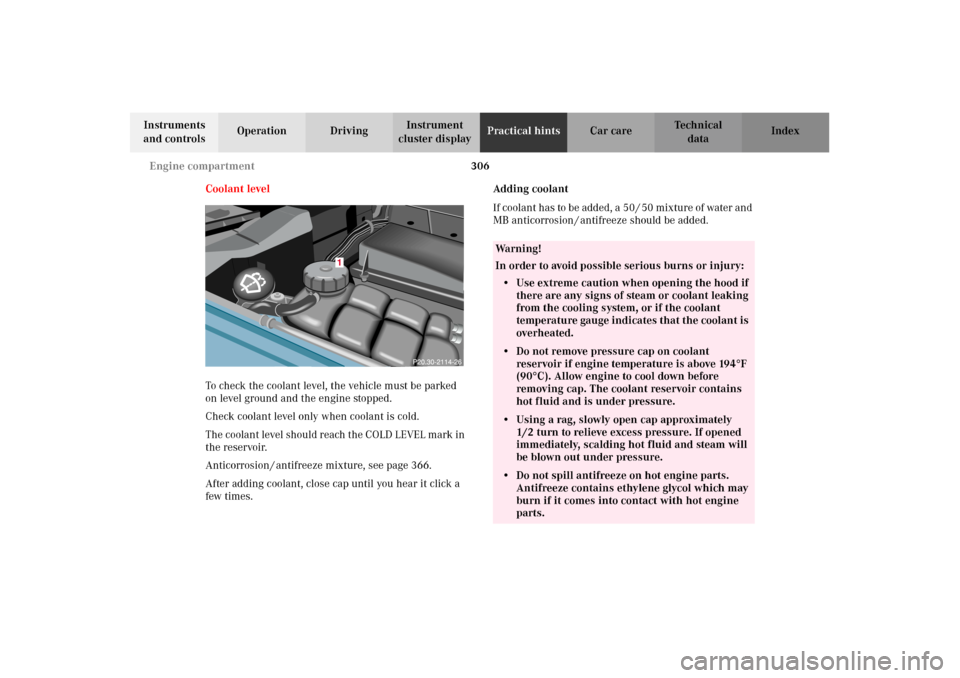
306 Engine compartment
Te ch n i c a l
data Instruments
and controlsOperation DrivingInstrument
cluster displayPractical hintsCar care Index
Coolant level
To check the coolant level, the vehicle must be parked
on level ground and the engine stopped.
Check coolant level only when coolant is cold.
The coolant level should reach the COLD LEVEL mark in
the reservoir.
Anticorrosion / antifreeze mixture, see page 366.
After adding coolant, close cap until you hear it click a
few times.Adding coolant
If coolant has to be added, a 50 / 50 mixture of water and
MB anticorrosion / antifreeze should be added.
1
Wa r n i n g !
In order to avoid possible serious burns or injury:
• Use extreme caution when opening the hood if
there are any signs of steam or coolant leaking
from the cooling system, or if the coolant
temperature gauge indicates that the coolant is
overheated.• Do not remove pressure cap on coolant
reservoir if engine temperature is above 194
°F
(90
°C). Allow engine to cool down before
removing cap. The coolant reservoir contains
hot fluid and is under pressure.
• Using a rag, slowly open cap approximately
1/2 turn to relieve excess pressure. If opened
immediately, scalding hot fluid and steam will
be blown out under pressure.• Do not spill antifreeze on hot engine parts.
Antifreeze contains ethylene glycol which may
burn if it comes into contact with hot engine
parts.
J_G463.book Seite 306 Mittwoch, 19. September 2001 8:06 08
Page 322 of 385
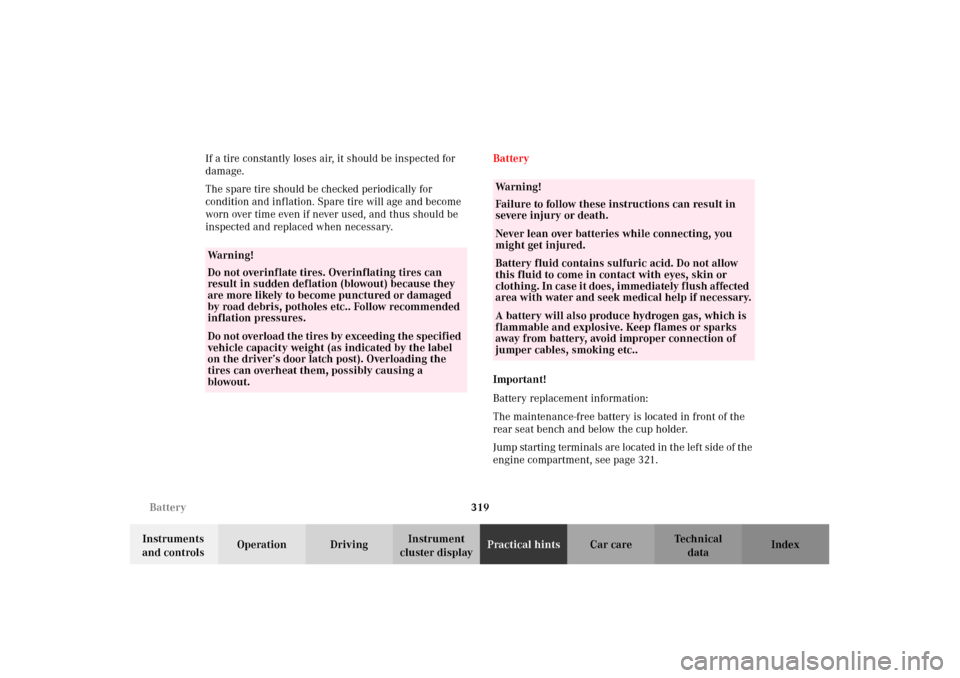
319 Battery
Te ch n i c a l
data Instruments
and controlsOperation DrivingInstrument
cluster displayPractical hintsCar care Index If a tire constantly loses air, it should be inspected for
damage.
The spare tire should be checked periodically for
condition and inflation. Spare tire will age and become
worn over time even if never used, and thus should be
inspected and replaced when necessary.Battery
Important!
Battery replacement information:
The maintenance-free battery is located in front of the
rear seat bench and below the cup holder.
Jump starting terminals are located in the lef t side of the
engine compartment, see page 321.
Wa r n i n g !
Do not overinflate tires. Overinflating tires can
result in sudden deflation (blowout) because they
are more likely to become punctured or damaged
by road debris, potholes etc.. Follow recommended
inflation pressures.Do not overload the tires by exceeding the specified
vehicle capacity weight (as indicated by the label
on the driver’s door latch post). Overloading the
tires can overheat them, possibly causing a
blowout.
Wa r n i n g !
Failure to follow these instructions can result in
severe injury or death.Never lean over batteries while connecting, you
might get injured.Battery fluid contains sulfuric acid. Do not allow
this fluid to come in contact with eyes, skin or
clot hin g. In cas e i t d oes , i mm ed ia tely f lus h a f fected
area with water and seek medical help if necessary.A battery will also produce hydrogen gas, which is
flammable and explosive. Keep flames or sparks
away from battery, avoid improper connection of
jumper cables, smoking etc..
J_G463.book Seite 319 Mittwoch, 19. September 2001 8:06 08
Page 326 of 385
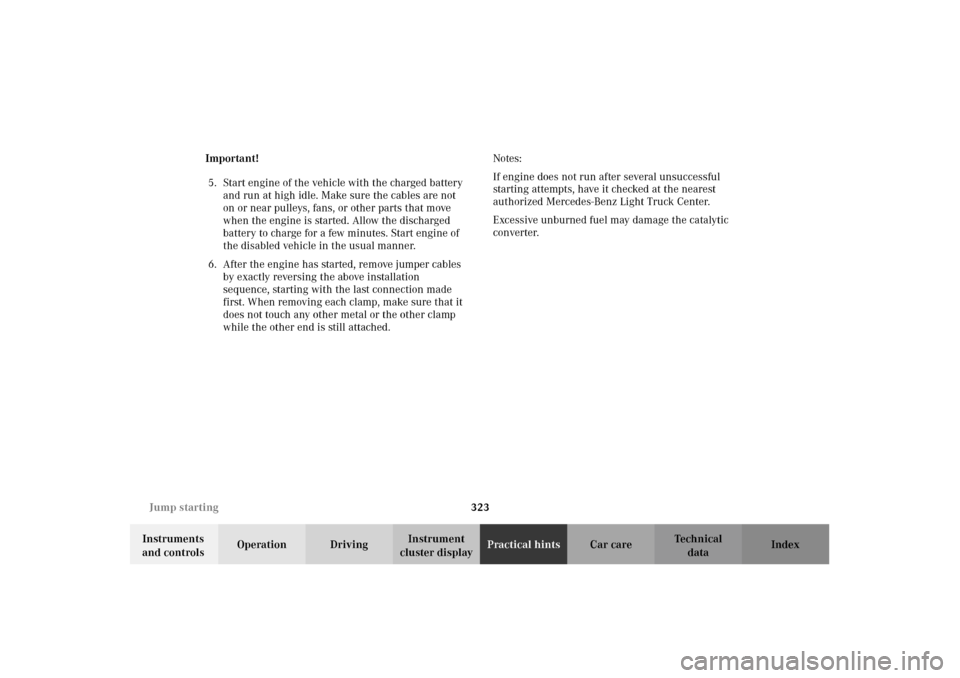
323 Jump starting
Te ch n i c a l
data Instruments
and controlsOperation DrivingInstrument
cluster displayPractical hintsCar care Index Important!
5. Start engine of the vehicle with the charged battery
and run at high idle. Make sure the cables are not
on or near pulleys, fans, or other parts that move
when the engine is started. Allow the discharged
battery to charge for a few minutes. Start engine of
the disabled vehicle in the usual manner.
6. After the engine has started, remove jumper cables
by exactly reversing the above installation
sequence, starting with the last connection made
first. When removing each clamp, make sure that it
does not touch any other metal or the other clamp
while the other end is still attached.Notes:
If engine does not run after several unsuccessful
starting attempts, have it checked at the nearest
authorized Mercedes-Benz Light Truck Center.
Excessive unburned fuel may damage the catalytic
converter.
J_G463.book Seite 323 Mittwoch, 19. September 2001 8:06 08
Page 369 of 385
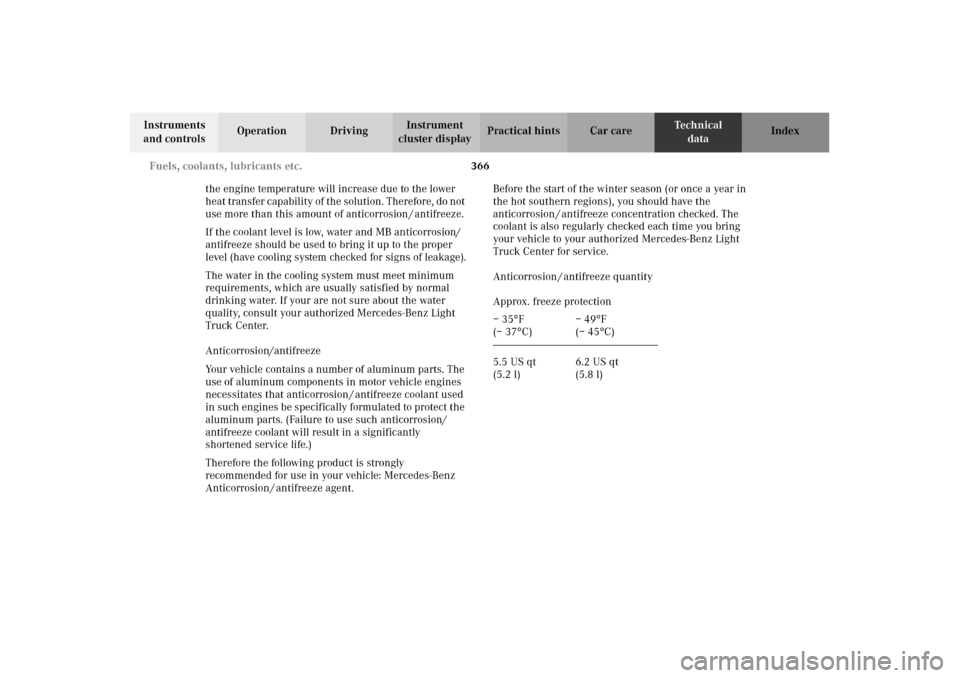
366 Fuels, coolants, lubricants etc.
Te ch n i c a l
data Instruments
and controlsOperation DrivingInstrument
cluster displayPractical hints Car care Index
the engine temperature will increase due to the lower
heat transfer capability of the solution. Therefore, do not
use more than this amount of anticorrosion / antifreeze.
If the coolant level is low, water and MB anticorrosion/
antifreeze should be used to bring it up to the proper
level (have cooling system checked for signs of leakage).
The water in the cooling system must meet minimum
requirements, which are usually satisfied by normal
drinking water. If your are not sure about the water
quality, consult your authorized Mercedes-Benz Light
Truck Center.
Anticorrosion/antifreeze
Your vehicle contains a number of aluminum parts. The
use of aluminum components in motor vehicle engines
necessitates that anticorrosion / antifreeze coolant used
in such engines be specifically formulated to protect the
aluminum parts. (Failure to use such anticorrosion/
antifreeze coolant will result in a significantly
shortened service life.)
Therefore the following product is strongly
recommended for use in your vehicle: Mercedes-Benz
Anticorrosion / antifreeze agent.Before the start of the winter season (or once a year in
the hot southern regions), you should have the
anticorrosion / antifreeze concentration checked. The
coolant is also regularly checked each time you bring
your vehicle to your authorized Mercedes-Benz Light
Truck Center for service.
Anticorrosion / antifreeze quantity
Approx. freeze protection
– 35
°F
(– 37°C)– 49
°F
(– 45°C)
5.5 US qt
(5.2 l)6.2 US qt
(5.8 l)
J_G463.book Seite 366 Mittwoch, 19. September 2001 8:06 08
Page 373 of 385
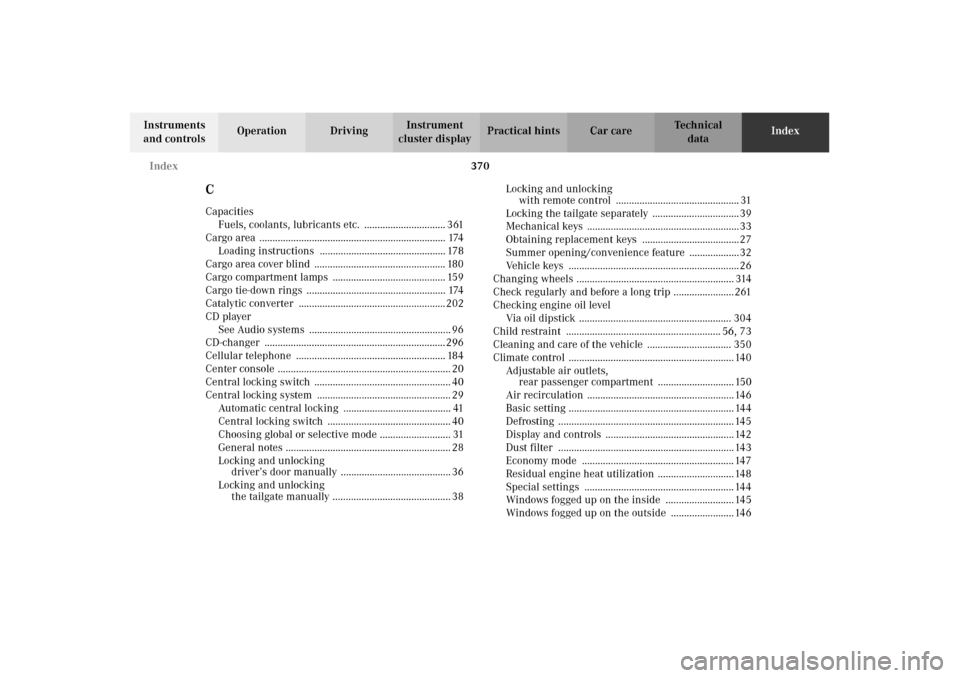
370 Index
Te ch n i c a l
data Instruments
and controlsOperation DrivingInstrument
cluster displayPractical hints Car careIndex
CCapacities
Fuels, coolants, lubricants etc. ............................... 361
Cargo area ....................................................................... 174
Loading instructions ................................................ 178
Cargo area cover blind .................................................. 180
Cargo compartment lamps ........................................... 159
Cargo tie-down rings ..................................................... 174
Catalytic converter ........................................................ 202
CD player
See Audio systems ...................................................... 96
CD-changer ..................................................................... 296
Cellular telephone ......................................................... 184
Center console .................................................................. 20
Central locking switch .................................................... 40
Central locking system ................................................... 29
Automatic central locking ......................................... 41
Central locking switch ............................................... 40
Choosing global or selective mode ........................... 31
General notes ............................................................... 28
Locking and unlocking
driver’s door manually .......................................... 36
Locking and unlocking
the tailgate manually ............................................. 38Locking and unlocking
with remote control ............................................... 31
Locking the tailgate separately ................................. 39
Mechanical keys ..........................................................33
Obtaining replacement keys .....................................27
Summer opening/convenience feature ...................32
Vehicle keys ................................................................. 26
Changing wheels ............................................................ 314
Check regularly and before a long trip ....................... 261
Checking engine oil level
Via oil dipstick .......................................................... 304
Child restraint ........................................................... 56, 73
Cleaning and care of the vehicle ................................ 350
Climate control ............................................................... 140
Adjustable air outlets,
rear passenger compartment ............................. 150
Air recirculation ........................................................ 146
Basic setting ............................................................... 144
Defrosting ................................................................... 145
Display and controls ................................................. 142
Dust filter ................................................................... 143
Economy mode .......................................................... 147
Residual engine heat utilization ............................. 148
Special settings ......................................................... 144
Windows fogged up on the inside .......................... 145
Windows fogged up on the outside ........................ 146
J_G463.book Seite 370 Mittwoch, 19. September 2001 8:06 08
Page 375 of 385
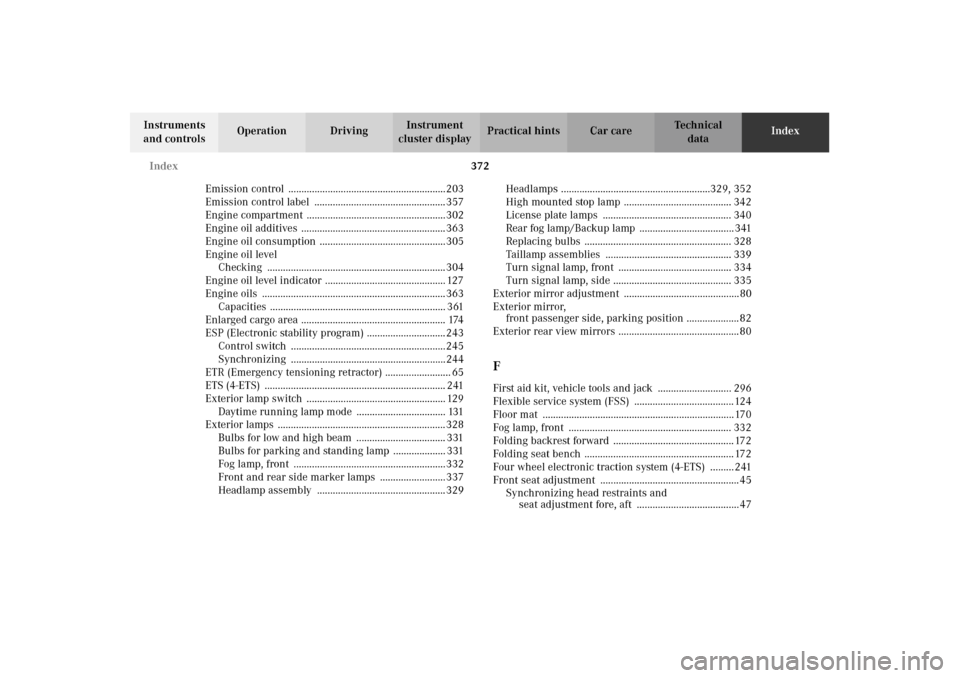
372 Index
Te ch n i c a l
data Instruments
and controlsOperation DrivingInstrument
cluster displayPractical hints Car careIndex
Emission control ............................................................203
Emission control label .................................................. 357
Engine compartment .....................................................302
Engine oil additives ....................................................... 363
Engine oil consumption ................................................305
Engine oil level
Checking .................................................................... 304
Engine oil level indicator .............................................. 127
Engine oils ...................................................................... 363
Capacities ................................................................... 361
Enlarged cargo area ....................................................... 174
ESP (Electronic stability program) .............................. 243
Control switch ...........................................................245
Synchronizing ...........................................................244
ETR (Emergency tensioning retractor) ......................... 65
ETS (4-ETS) ..................................................................... 241
Exterior lamp switch ..................................................... 129
Daytime running lamp mode .................................. 131
Exterior lamps ................................................................ 328
Bulbs for low and high beam .................................. 331
Bulbs for parking and standing lamp .................... 331
Fog lamp, front ..........................................................332
Front and rear side marker lamps ......................... 337
Headlamp assembly ................................................. 329Headlamps .........................................................329, 352
High mounted stop lamp ......................................... 342
License plate lamps ................................................. 340
Rear fog lamp/Backup lamp .................................... 341
Replacing bulbs ........................................................ 328
Taillamp assemblies ................................................ 339
Turn signal lamp, front ........................................... 334
Turn signal lamp, side ............................................. 335
Exterior mirror adjustment ............................................80
Exterior mirror,
front passenger side, parking position .................... 82
Exterior rear view mirrors .............................................. 80
FFirst aid kit, vehicle tools and jack ............................ 296
Flexible service system (FSS) ...................................... 124
Floor mat ......................................................................... 170
Fog lamp, front .............................................................. 332
Folding backrest forward .............................................. 172
Folding seat bench ......................................................... 172
Four wheel electronic traction system (4-ETS) ......... 241
Front seat adjustment ..................................................... 45
Synchronizing head restraints and
seat adjustment fore, aft ....................................... 47
J_G463.book Seite 372 Mittwoch, 19. September 2001 8:06 08